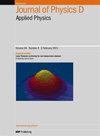Advanced defect spectroscopy in wide-bandgap semiconductors: review and recent results
IF 3.1
3区 物理与天体物理
Q2 PHYSICS, APPLIED
引用次数: 0
Abstract
The study of deep-level defects in semiconductors has always played a strategic role in the development of electronic and optoelectronic devices. Deep levels have a strong impact on many of the device properties, including efficiency, stability, and reliability, because they can drive several physical processes. Despite the advancements in crystal growth, wide- and ultrawide-bandgap semiconductors (such as gallium nitride and gallium oxide) are still strongly affected by the formation of defects that, in general, can act as carrier traps or generation-recombination centers (G-R). Conventional techniques used for deep-level analysis in silicon need to be adapted for identifying and characterizing defects in wide-bandgap materials. This topical review paper presents an overview of reviews of the theory of deep levels in semiconductors; in addition, we present a review and original results on the application, limits, and perspectives of two widely adopted common deep-level detection techniques, namely capacitance deep-level transient spectroscopy and deep-level optical spectroscopy, with specific focus on wide-bandgap semiconductors. Finally, the most common traps of GaN and β-Ga2O3 are reviewed.宽带隙半导体中的高级缺陷光谱学:回顾与最新成果
对半导体深层缺陷的研究在电子和光电设备的发展中一直发挥着战略性作用。深层缺陷对器件的许多特性(包括效率、稳定性和可靠性)都有很大影响,因为它们可以驱动多个物理过程。尽管晶体生长技术不断进步,但宽带隙和超宽带隙半导体(如氮化镓和氧化镓)仍然受到缺陷形成的强烈影响,这些缺陷一般可作为载流子陷阱或世代重组中心(G-R)。用于硅深层分析的传统技术需要进行调整,以识别和表征宽带隙材料中的缺陷。这篇专题综述论文概述了半导体中深电平理论的综述;此外,我们还介绍了两种广泛采用的常用深电平检测技术(即电容深电平瞬态光谱法和深电平光学光谱法)的应用、限制和前景方面的综述和原创性成果,并特别关注宽带隙半导体。最后,综述了 GaN 和 β-Ga2O3 最常见的陷阱。
本文章由计算机程序翻译,如有差异,请以英文原文为准。
求助全文
约1分钟内获得全文
求助全文
来源期刊
CiteScore
6.80
自引率
8.80%
发文量
835
审稿时长
2.1 months
期刊介绍:
This journal is concerned with all aspects of applied physics research, from biophysics, magnetism, plasmas and semiconductors to the structure and properties of matter.

 求助内容:
求助内容: 应助结果提醒方式:
应助结果提醒方式:


